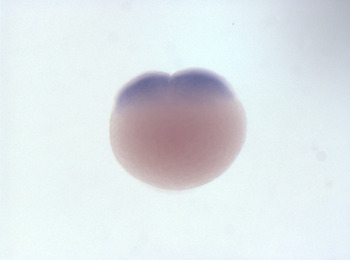This decommissioned ERA site remains active temporarily to support our final migration steps to https://ualberta.scholaris.ca, ERA's new home. All new collections and items, including Spring 2025 theses, are at that site. For assistance, please contact erahelp@ualberta.ca.
- 241 views
- 268 downloads
Not such an "unc"oordinated development
-
- Author(s) / Creator(s)
-
This image is a fertilized zebrafish embryo that has undergone a single cell-division - a critical first step to become a fully developed fish. Zebrafish embryos must be self-sufficient since the mother lays these embryos before they even become fertilized. After fertilization, the embryo relies on two factors to become a fish: 1. the yolk (pink) which contains nutrients and 2. essential information (mRNA transcripts) that the mother deposits into the cell - these transcripts give rise to the cellular proteins that tell the embryo how to properly divide cells and pattern the embryo until it can turn on its own genes (which doesn't occur for another three hours after this first cell division!). In this fish, the unc119c mRNA transcript is labelled using in situ hybridization (purple in two cells). The unc119 genes in humans give rise to retinal disease; however, cell culture studies suggest unc119 genes likely affect many tissues. The presence of the unc119 mRNA transcript at this early stage (before eye formation has begun) indicates that these genes do, in fact, affect tissues outside of the eye. This validates the use of zebrafish to study what these roles might be in a vertebrate system. // Program of Study: PhD // Department: Biological Sciences, Faculty of Science // Place of creation: University of Alberta // Award: Semi-finalist Prize, Images of Research Competition 2018
-
- Date created
- 2018-01-01
-
- Subjects / Keywords
-
- Type of Item
- Image
-
- License
- Attribution 4.0 International
